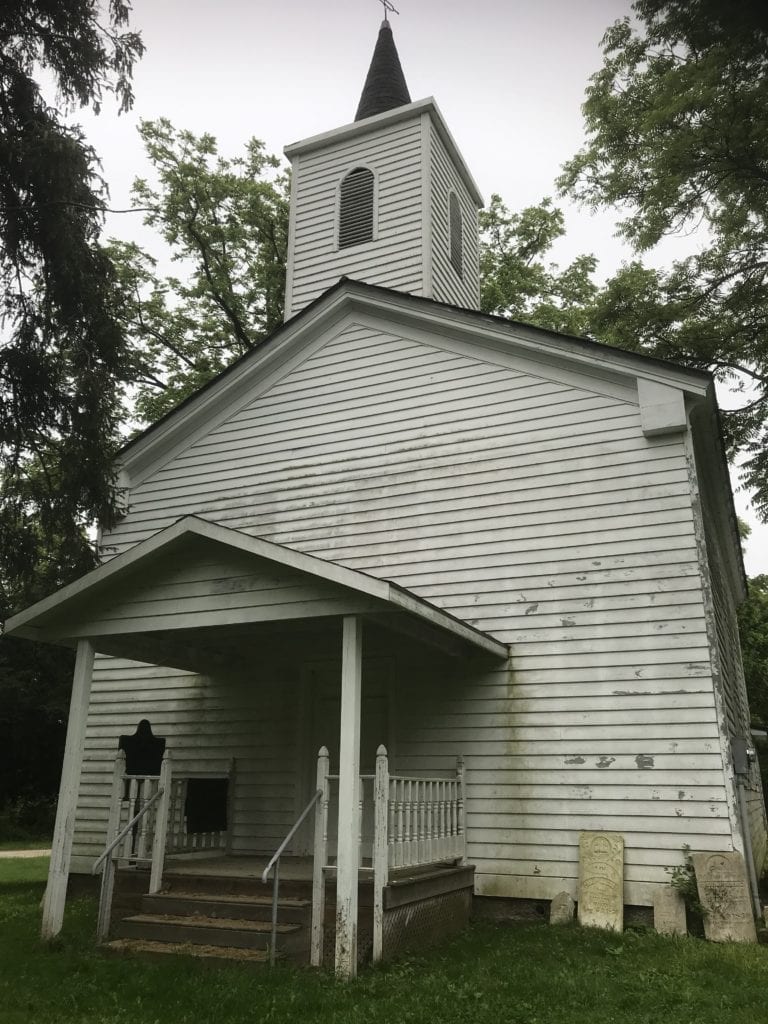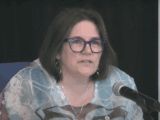The scene is a familiar one in rural southwestern Ontario – a stand of trees surrounded by a farmer’s field. But if this piece of land could talk, it might tell stories of Fairfield, a thriving village where missionaries and Indigenous people lived together, welcoming travellers who passed through the region.
It might tell the tale of Shawnee Chief Tecumseh, fatally wounded at the Battle of the Thames on Oct. 5, 1813, less than four kilometres away. It might bear witness to those American soldiers burning the village to the ground as they returned to Fort Detroit. And today, it might rejoice at being reunited with the First Nation that settled it 227 years ago.
On May 10, this piece of land east of Thamesville, Ont. was transferred from The United Church of Canada to the Eelūnaapèewii Lahkèewiit, more commonly known as the Lenape (Lunaapeew) people of the Delaware Nation at Moraviantown.
The historic signing marked a significant step towards reconciliation between Indigenous people and the United Church, says Joyce Payne, president of Antler River Watershed Regional Council. “It was a wonderful opportunity for us to put into practice the Truth and Reconciliation Commission’s calls to action,” she says.
The land transfer is being completed in two phases, starting with the five-acre field north of Longwoods Road, finalized this May. The United Church bought the land from a farmer in 1981.
This will be followed by the return of the site of the original Fairfield settlement across the road, which the United Church has operated as a museum and historic park since 1945.

The field holds special significance for the Lenape, says Eelūnaapèewii Lahkèewiit Chief Denise Stonefish. The stand of trees marks the village of Fairfield’s ancestral burial site.
“We’ve always felt a connection to that land. Our ancestors are there,” Stonefish says. “We revere our ancestors, so we felt like our community wasn’t whole.”
Fairfield was one of the region’s first settlements. It was established on May 8, 1792 by Eelūnaapèewii Lahkèewiit ancestors and the Moravian missionaries who had lived among them for generations. Both groups were fleeing persecution in the United States after refusing to take sides during the American Revolution.
Fairfield was self-supporting and had the region’s first church and school. It remained an important centre until its inhabitants were forced to flee ahead of American soldiers who destroyed the settlement on Oct. 5, 1813.
“Our people were scattered, but we came back,” Stonefish says.
New Fairfield was established across the river, on the southern shores of the Thames, in 1815. It was eventually renamed Moraviantown, although the Moravians turned their mission work over to the Methodists in 1902.
Today, Moraviantown is home to an estimated 574 Lenape, with another 1,100 registered members living throughout Ontario and beyond. The mission house and church built in the mid-1800s still stand, and serve as the community’s public library.

The journey to reunify Moraviantown with the site of the original Fairfield settlement has been a long one. “We’ve always laid claim to those lands,” Stonefish says. Lenape leaders, including former Chief John Peters, have been working on having the lands returned since the 1950s.
“In the past, I gather [the United Church] was holding on to the settler mentality,” says Payne. The Truth and Reconciliation Commission inspired a change of heart, and once recent United Church restructuring, which saw regional councils replace conferences, was over, the path was clear for a final agreement to be reached.
Payne attended the signing ceremony this spring. “To put feet to the word reconciliation has been very exciting and very humbling,” she says. “Listening to community members speak about what it means to be able to visit their ancestors at the grave site was very moving.”
Stonefish says the Fairfield land transfer will provide opportunities for her Nation to create new spaces where they take the lead in sharing their own stories, history and culture. Plans include commemorating the ancient burial ground and eventually developing the Fairfield Museum site into an interpretive centre that explores the Lenape Nation’s history.
“Our Nation has long dreamed of the return of our first home in these lands,” she says. “We thank the Antler River Watershed Regional Council of The United Church for their good faith, good will and leadership to help us make this dream a reality.”
For more of Broadview‘s award-winning content, subscribe to the magazine today.
















I am delighted to see the United Church support of Indigenous rights, as illustrated in this example.
But I continue to be puzzled at the lack of support ( indeed, the opposite) when it comes to the indigenous rights of them Jewish People and the land of Israel. I appreciate that the problems are complex and that two nations for two people (Jewish and Palestinian) is the basis for the solution. But the Palestinians have clearly turned down multiple offers ( including the original UN resolution in 1948 which would have done just that. They have not entered negotiations in years. They openly deny historic Jewish ties to Israel. So why take a stand against Jewish aspirations for the restoration of the Jewish indigenous rights. It is perplexing and seems to be rooted in antisemitism more than in Israeli reluctance to negotiate with Palestinians.
This is wonderful news! Hopefully, this example of putting “reconciliation” into action will inspire others, all across Canada, to do the same! Congratulations!
I am so proud to be a member of The United Church of Canada. Once again, you have led the way. With God as our Guide, one step at a time, history is being rewritten in many different humanitarian ways because of the call to action and the very judicious work of our Church leadership and Church community.
With much appreciation,
Gay Gray
Antler River Watershed Regional Council of the United Church has indeed “put feet to the word reconciliation”. Good news!
French is becoming a natural part of our services at Saint-Lambert United. We are a strong anglophone congregation in a majority francophone community. So many in our congregation are fluently bilingual. Truly enriching, I find.
After 20 years of nearly fulltime research, I have concluded that the LENAPE originally were Catholics, who spoke Norse.
The 17th century English masked the “Catholics, who spoke Norse” by using the “Indian” word, which Columbus called Americans without evidence.
The English used suppression by omission to deny the knowledge of the Catholics, who spoke Norse.
This transfer of land from the Church of Canada to the Delaware (a.k.a Lenape) restores the religious balance between Churches. The Chistian principle of freedom of religion is strengthened.